

Point Lookout Lighthouse
Eunice
Metivier Knott Interview
by Robert Hall
On November 7, 2004, Robert spoke with Mrs. Eunice Metivier Knott about her experiences at Point Lookout Lighthouse.
Eunice was born in 1932 to Herman and Marguerite Metivier at Cove Point Lighthouse in Calvert County, Maryland. In 1939, her father transferred to Point Lookout Lighthouse, where he served as assistant keeper under R. Westly Fulcher. Mr. Fulcher suffered a stroke in 1942, and retired on medical disability in May of 1943; Mr. Metivier was promoted to keeper and Zadock Sturgis transferred to Point Lookout as the assistant keeper1. The Metivier's lived on the south side of the lighthouse and the Fulcher and Sturgis families lived on the north side.
Mr. Metivier was known as Mac, probably because his last name was too long to say. In addition to performing his official lighthouse duties, Mr. Metivier was a very talented wood and metal worker and had his own shop in the basement under the living room. He completed many projects at the lighthouse, including customizing the south side kitchen cupboards, with closets on both sides of the built-in cabinets, and painting using a stipple technique to make the painted walls look like wallpaper. He also made a metal countertop that included a pull out shelf that his wife used to make bread. One time he made a replacement metal part for a boat that had broken down at the point; if the part had been ordered, it would have taken a long time to be delivered to an isolated place like Point Lookout.
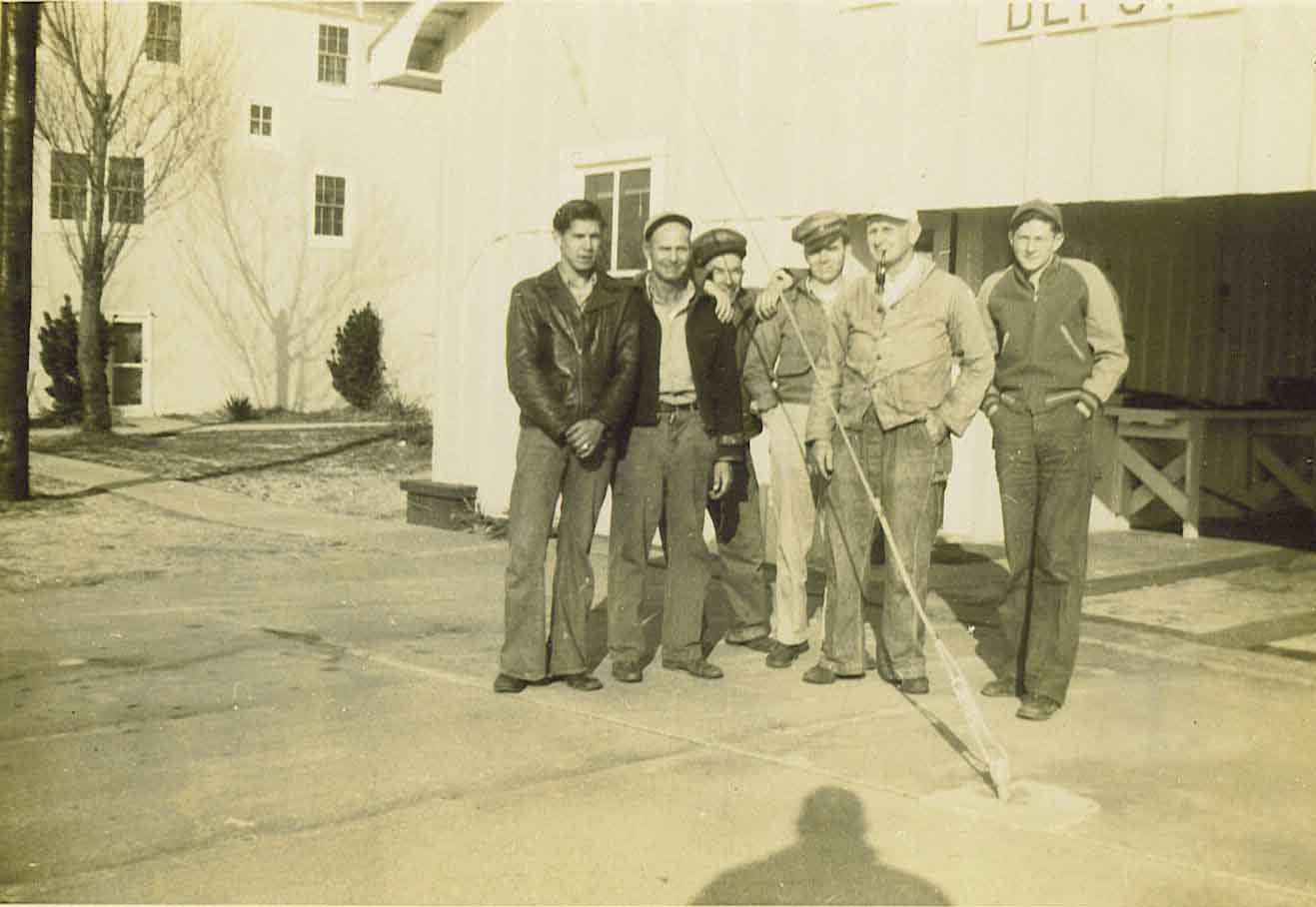
|
Pictured from left to right are: Bob Younkins (from Washington state), Eunice's Father in Law Webster Knott, Herman Metivier, Ralph Metivier (Eunice's brother), Zadock Sturgis, and Wally Sturgis, Jr.(Zadock Sturgis' son) |
During WWII there were about 20 sailors living in the barracks. The barracks faced the Potomac River and contained bunks, a kitchen and a bathroom. Landing Ship Tanks (LSTs) came to the area during World War II to practice maneuvers. Marines and sailors couldn't be on the beach at the same time or they would end up fighting, and there was a bar on every corner from Leonardtown all the way down to Point Lookout to accommodate the soldiers.
Many people drowned at the point. Sometimes, the uniformed tourist would just start walking on the sandbar off the point, not understanding how quickly the sandbar dropped off into deeper water. The deep water combined with the strong currents at the confluence of the Bay and the Potomac River would conspire to pull the poor soul under. When the Metivier's first moved to the lighthouse, the lighthouse was unprotected, but eventually a gate was installed to keep out the curious.
The kitchen had a kerosene cook stove and the dining room wall had a phone with a crank that had to be wound in order to make a call. As was common at the time, the line was a party line, and anyone on the party line could listen in on your conversation. If someone was using the line when you picked up the receiver, you had to replace the receiver and wait until the other party finished their call. The lighthouse was heated with coal, which was loaded into the furnace through the outside basement doors on the northwest side of the lighthouse. Mr. Metivier planted poplar trees and flower bushes around both sides of the lighthouse. Unfortunately, these adornments were later removed because of the maintenance involved to keep the grounds looking nice.

Point Lookout Lighthouse, with landscaping.
The tenders delivered damaged buoys and supplies, and picked up repaired all
types of buoys. Eunice's
mother made donuts for the crews of the tenders.
When she made donuts she would fill up a lard tin (about 2 1/2 feet tall)
full of donuts. The sailors looked forward to the homemade cake donuts,
that were made with lard and mashed potatoes and were very moist and delicious.
Eunice found the recipe and tried making them, but they just didn't
taste like her mother's. Mrs. Metivier also made bread, but never at the same
time as the donuts. Eunice
had her mother's sifter, but it was rusted too badly to salvage.
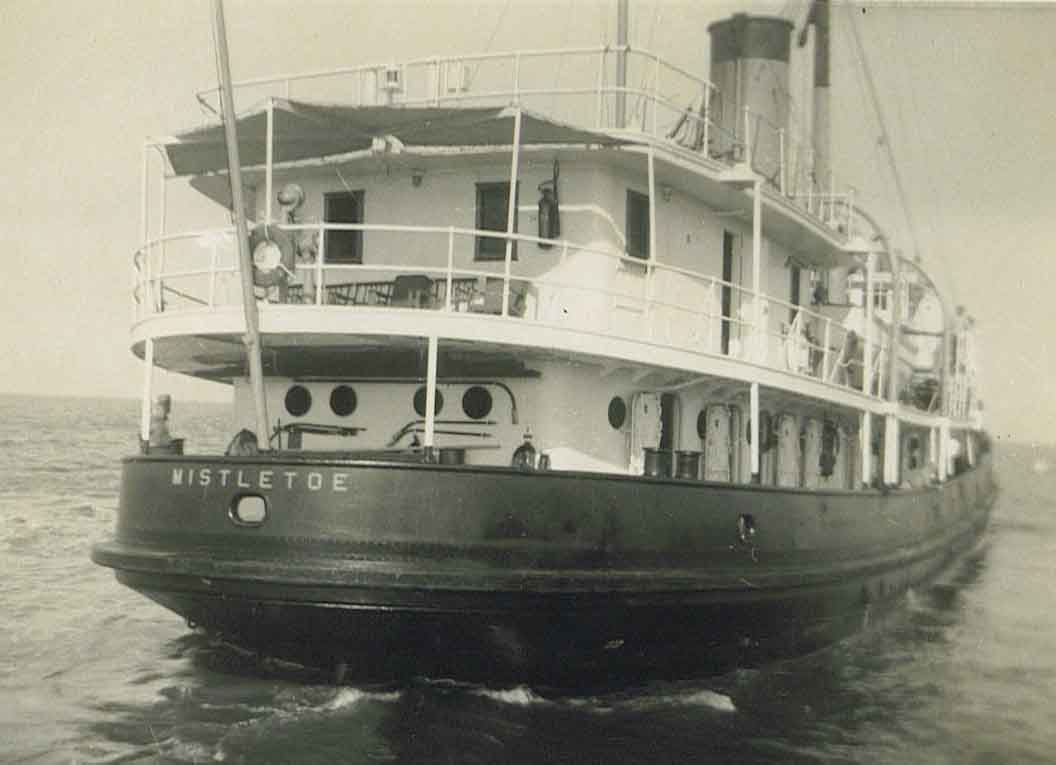
The Tender
MistleToe.
The building next to the lighthouse was the radio shack and buoy repair shed; the next building was the coal shed, then the barracks. Mr. Metivier kept his car on ramps behind the barracks. The engine room, which housed the generator, was the farthest away from the lighthouse.
Both families had gardens and raised livestock. There was a grape arbor and a fig orchard on the property. The Metivier's raised goats and chickens, and Eunice grew up on goat's milk. The family had to retrieve the goats from the Potomac River after a storm washed over the point. Visitors to the point would sometimes approach the goat in the yard, but would make a hasty retreat once they realized how badly the animal smelled! The goat pen was behind the fig orchard, which was east of the present day smoke house. Eunice's mother enjoyed gardens and flowers, and raised chickens; the baby chicks were hatched in the smokehouse. The Sturgis' had hogs and a cow.
The Coast Guard records had a report that the keeper was selling fishing licenses, and an official was sent to Point Lookout to investigate the complaint. The official tried to trick Mr. Metivier into selling him a license but was thoroughly rebuked. The official account is full of glowing praise for Mr. Metivier, including many people in the vicinity of the lighthouse who vouched for his good character. Eunice was unaware of the investigation at the time of this interview. Mr. and Mrs. Metivier were very religious people and were dedicated to their church, a non-denominational church in Washington, D.C. called Christians Gathered in the Name of the Lord.

Randy with the Sturgis' Dog, Chessie
The adults kept to themselves, but since the area was so isolated, the children all played together. The middle room in the south side basement was the children's playroom, and nothing supernatural occurred there. Mr. Metivier used his woodworking skills to build a dollhouse for the girls. The lighthouse children also enjoyed swimming, however, the jellyfish were just as bad as they are today and just like now, they had to pick and choose the time to swim, according to the weather to avoid the pesky nettles. The children would jump off the end of the buoy pier into 30 feet of water. Jack Sturgis would swing off the boom of the tender, and then jump into the water. There was a ladder on the squared off part of the pier, where the children would climb back up onto the pier. The Sturgis' had three boys: Wally, Paul and Jack. Wally was the wildest of the three, with Jack being a close second (Wally passed away a number of years ago).
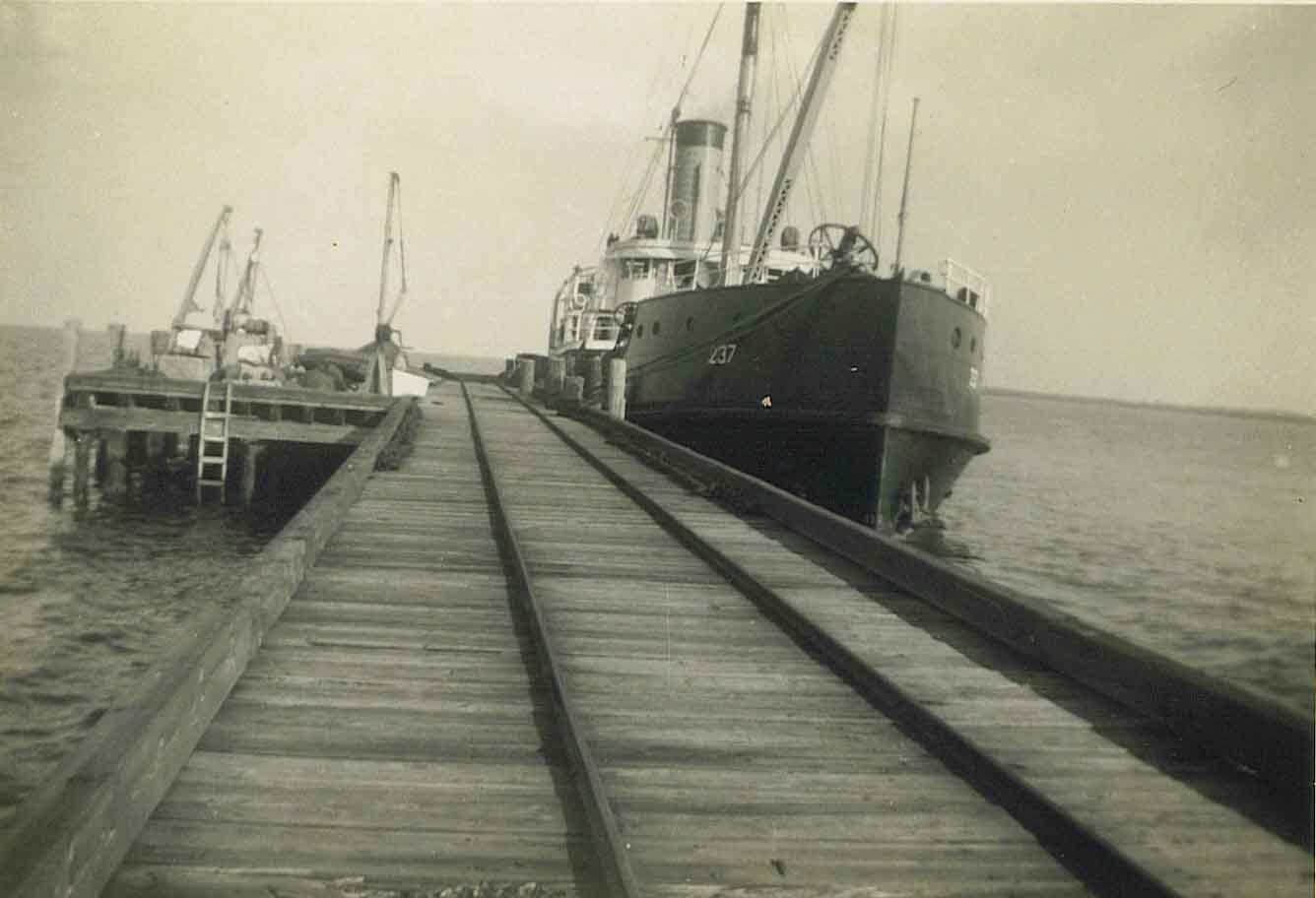
The
Tender MistleToe. Notice the ladder on the left hand side of the dock.
Eunice lived at Point Lookout lighthouse from June 1939 until June 1952. Her bedroom was on the south side, facing the Potomac River. In that room, four girls slept in two twin beds. When Eunice's granddaughter toured the lighthouse with her Brownie troop in September 2004, she was in shock to learn that more than one child slept in a single bedroom, and even more surprised to learn that more than one child slept in a single bed! When Eunice was a child, girls were never allowed to wear pants. One day when Eunice was playing on the lighthouse grounds she decided to do summersaults, but unfortunately her father witnessed the entire event from the lighthouse tower. He ran to the children and paddled Eunice all the way home because the summersaults had made her britches visible for the entire world to see! When Eunice was about 13 years old, she had some friends visit from Virginia, and one night they walked out on the pier. There was a buoy to the right of the pier and everyone saw a white object sitting on top of the buoy. Someone said it was a sailor sitting on the buoy, but it was most likely a seagull. Nonetheless, Eunice grabbed her sister's skirt and said you are not leaving me out here! On another occasion, Mr. Metivier yelled to Eunice to go get her mother, because Matilda was having a baby. Eunice became very flustered and replied who is Matilda? Her father began laughing and said: "The cow!"
Eunice attended school with Wally Sturgis, one of the assistant keeper's sons. At first, the school bus only came as far as the Powell House, just south of the causeway. At the time, there were ten children living in the lighthouse. Mr. Metivier made inquiries and eventually managed to have the lighthouse children picked up in front of the lighthouse. The other children at school teased the lighthouse children about how special they must be to have the bus come down to the lighthouse to pick them up! Eunice did not get to attend her high school graduation, because her father had made a previous commitment for a church function, and would not break that commitment to go to the graduation. Eunice cried and cried to no avail. Finally, she pressed her gown, dressed in her graduation outfit and had her picture taken with her parents. Her mother offered to take Eunice to the graduation and send her father off on his own, but Eunice knew that her father would get lost driving in D.C., and accepted that she would not be attending her high school graduation.

Eunice Metivier in her cap and gown, with her parents.
After graduating high school, Eunice left the lighthouse to attend nursing school. She completed the training, however, her parents had once again made other commitments and could not attend her graduation ceremony. Eunice was determined to go to this graduation, and she was just being honest when she said if she were to die on her way to her graduation, she would just have to die. She wasn't challenging God, but really wanted to attend the ceremony after completing her studies. She attended the graduation, although she was just getting over a bad bout with the flu.
Julius Knott was living north of the causeway and had replaced Herbert Yeatman at the lighthouse. Julius graduated in 1947 and worked at the lighthouse from 1949 thru 1956, and his duties included: painting (buoys, signs and houses), covering the radio and making general repairs.
After Eunice completed her nurses
training, she came back to Point Lookout and asked Julius Knott, who was working
at the lighthouse, to go swimming, and in her words, that “got the ball
rollingâ€. Eunice hated the pools
in DC and preferred the familiar salt water.
Eunice married Julius Knott, however, no one from Eunices family
attended the wedding. Julius
got along well with his father in law and was friends with Elton Gaines, a
sailor stationed at the lighthouse.
People would net the crabs that clung to the pilings on the wharf, however, Mr.
Metivier would not allow a crab in his house, because he once saw a body pulled
from the water that was covered with crabs.
He would use the crabs for bait or give them to someone who would eat
them, but other than that he wanted no contact with the crustaceans.
When people visited the lighthouse, they would sometimes bring a bushel
of crabs but Mr. Metivier wouldn't allow the crabs in the house. Because of her father's bad experience with crabs, Eunice
never experienced the taste of steamed crabs until she met Julius.
Julius used to tease Eunice, calling her a rich girl because the
lighthouse had a generator to supply electricity.
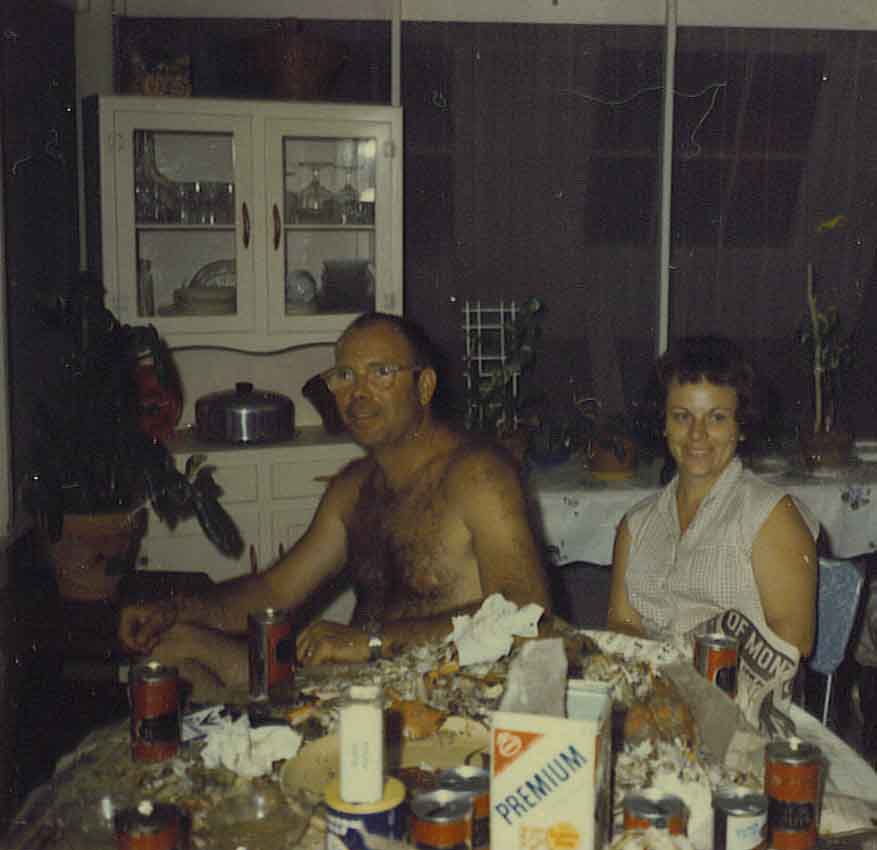
|
Julius and Eunice Knott eating crabs on his family's back porch.This picture was taken at Julius' childhood home after the couple was married. This property was destroyed by a fire some years later |
.
The salt air was tough on anything
exposed to it, so painting and re-painting was a way of life at the lighthouse.
One day when Julius was painting the lighthouse, he decided that he would
chew tobacco (like Mr. Sturgis did), until he realized that the tobacco juice
had run down the side of the lighthouse, ruining his work.
Since he had to repaint the entire area, he decided that painting and
chewing tobacco was not a wise combination.
The salt air was also hard on automobiles, and the sea would run over the
causeway during storms, causing major damage to the undercarriage.
To ward off the damage, locals would get special undercoating for their
vehicles. In the picture
below, Julius had just finished painting the sign (to be put up over the buoy
shed).
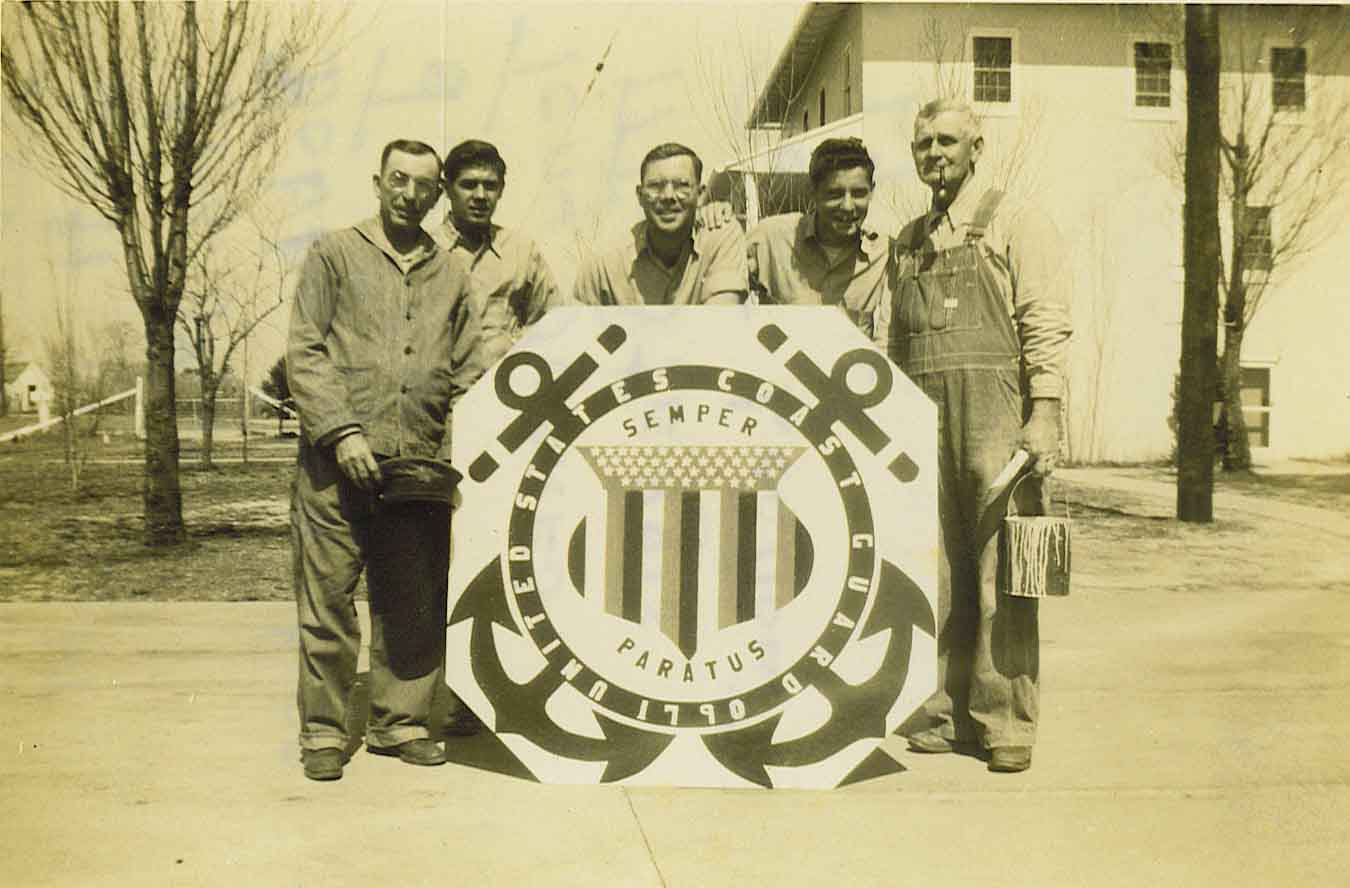
|
Julius Knott painted the Coast Guard Sign. Pictured from left to right are: Herman Metivier, Bobby Younkins (from Washington state), Julius Knott, Tony Borres, and assistant keeper Zadock Sturgis. |
GHOSTS
Over the years, former keepers and
their families have provided very few reports of unusual activity around the
lighthouse. Julius Knott had
an experience, just before he and Eunice were married.
He was walking from the old Point Lookout Hotel toward the lighthouse to
cover for Mr. Metivier. As he
walked, he saw a lantern appear ahead of him and then it mysteriously drifted
out over the bay. No natural
cause has been determined for the event.
Dick Rowan, a sailor of small stature, would sit in the radio shack with a rifle
across his lap. He was very
skittish; if you said boo to him he would jump, so maybe that’s why he had a
rifle. It is unclear if he ever had
an experience that frightened him, or if he was just born skittish.
But one thing was for sure: everyone knew not to barge into the radio
shack unannounced!
Mr. Metivier was in charge of the lighthouse from 1943 until he retired on October 1, 1954. After his retirement, he moved to Prince Georges County and worked at the Post Office for a few years before fully retiring. Mrs. Marguerite Mildred Metivier passed away in June of 1975 from a stroke. Mr. Metivier passed away 4 months later from a stroke. He would have been 81 years old that November. Except for Eunice, the Metivier children scattered around North America as adults. Ester was the oldest, followed by Ralph, Grace, Virginia and then Eunice. Ralph lived in Chesapeake, Virginia until April 18, 2015, when he passed away after a long illness. The Metivier children were about 2 years apart, except for Virginia and Eunice who were farther apart in age.
Eunice's husband, Julius Knott, passed away in January 2004, after a prolonged illness. With her brother Ralph's passing, Eunice is the only remaining sibling. She can be found volunteering at the Point Lookout Lighthouse Preservation Society's events, regaling visitors with her memories of growing up in a very special land-based, integral lighthouse.
November 7, 2004
 |
 |
| Eunice Metivier
Knott, standing on the South Side steps of her childhood home, Point
Lookout Lighthouse. (Robert Hall on the left.) |
Neighbors across time: Eunice Metivier Knott standing at the south side kitchen entrance where she once lived; Laura Berg standing at the north side kitchen entrance where she lived some years later. |
We would like to thank Mrs. Knott for allowing us to display her pictures and
tell her life story! If you
visit the Cove Point Lighthouse (now owned by the Calvert Marine Museum), be
sure to look at the pictures of the Metivier family that were donated by her
brother, Ralph Metivier.
NOTES:
1
Since Mr. Metivier converted to the Coast Guard, his official grade was
Boatswains Mate First Class (BM1/C) and he was the Officer in Charge (OIC).
Zadock Sturgis sometimes signed the lighthouse logbook as keeper, which
confused the Coast Guard grades with actual roles, as "Keeper" was not a
Coast Guard title. For the
sake of clarity, the terms keeper and assistant keeper are used to distinguish
who was in charge of the lighthouse.
For full details, see:
www.ptlookoutlighthouse.com/Keepers/HermanMetivier/HermanMetivier.htm
and
www.ptlookoutlighthouse.com/Keepers/ZaddockSturgis/ZadockWSturgis.htm